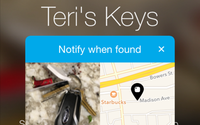Commentary
Lost Keys Or Suitcase? IoT Peer Power Steps In
- by Chuck Martin , Staff Writer, April 17, 2016

After several hours on a plane, you dutifully make your way to baggage claim only to watch the conveyor belt, once finally started, with great anticipation that your bag made it.
Some time ago, airlines like Delta finally linked baggage tracking into their app. So now, when you arrive at your destination, you can quickly see that your luggage didn’t make the trip with you, for whatever reason.
After waiting in line at luggage control, the beleaguered attendant, who fields only bad news all day or night, asks for some info on your bag. Yes, it’s black, like most others. A search inside their system shows that it will be arriving in a few hours and the airline will have it delivered to your hotel or home.
And sure enough, at 3 in the morning, a bell rings and you and your luggage are reunited.
The Internet of Things promises to change all of that. Kind of.
Luggage maker Samsonite just introduced something called Track & Go, luggage with built-in beacons, allowing suitcases to be tracked by their owner via mobile app.
As you likely know, Bluetooth Low Energy (BLE) beacons have a limited range, so when the suitcase is in transit, it can’t be connected to the app. In the case of Samsonite, the maximum distance to stay connected is 75 yards.
And that’s where what I call IoT Peer Power comes in.
When out of sight, the suitcase owner taps the app to flag that their luggage is missing, so that whenever anyone with the Samsonite app on their phone passes within 75 yards of the luggage, the beacon signal is picked up, triggering a notification with location and time details of the suitcase sent to the owner.
But it’s not only in luggage where IoT Peer Power comes into play.
Sensors can be easily connected to pretty much anything that moves.
As she would readily admit, my wife Teri often misplaces her keys. Like luggage, the keys are not really lost; she just doesn’t know exactly where they are at the moment.
So I got her a Tile, a small Bluetooth tracker, and attached it to her keys. I tap the Tile app to start a ‘Teri’s keys’ search and can tell when I get closer to them, as well as the tile emitting a constant sound, which makes them even easier and quicker to find.
But here’s where IoT Peer Power comes in. If Teri is walking around Boston and has happened to leave her keys at a Starbucks along the way, I hit the ‘Lost’ button on the app and all other Tile apps that anyone has on their phone become part of the automatic search committee. When someone with the app is near the Starbucks, I get a location notification of where the keys are. It works.
The IoT Peer Power members don’t necessarily need to know that they are part of the overall solution. They also don’t need to do anything, other than have a relevant app on their phone.
The challenge for businesses that attempt to leverage IoT Peer power is scale.
This reminds me of the very early challenge with fax machines.
One fax machine was useless, for obvious reasons. The more fax machines installed increased the value and power of the network.
The same will be true for IoT Peer Power.
Companies like Samsonite and Tile, among others, will have to invest in some serious marketing to get their apps on more phones.
But once at scale, those IoT Peer Power networks can be used for other things even yet to be dreamed of.



